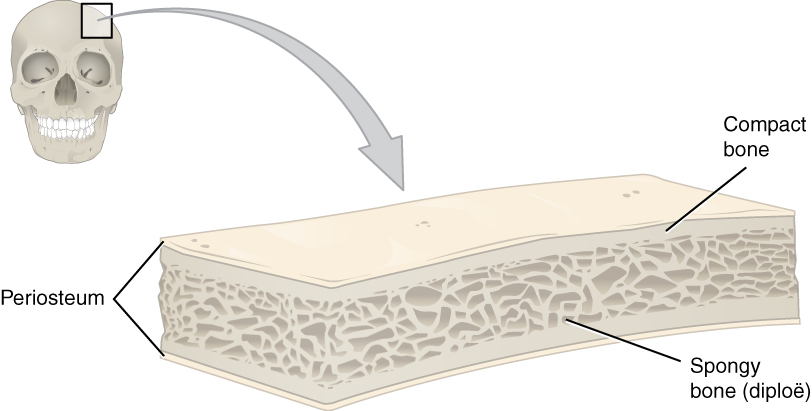SKELETAL SYSTEM (TYPES OF BONES AND PARTS)
The skeletal system includes all of the bones and joints in the body. Each bone is a complex living organ that is made up of many cells, protein fibers, and minerals. The skeleton acts as a scaffold by providing support and protection for the soft tissues that make up the rest of the body. The skeletal system also provides attachment points for muscles to allow movements at the joints. New blood cells are produced by the red bone marrow inside of our bones.Bones act as the body’s warehouse for calcium, iron, and energy in the form of fat. Finally, the skeleton grows throughout childhood and provides a framework for the rest of the body to grow along with it.
Skeletal System Anatomy
The skeletal system in an adult body is made up of 206 individual bones. These bones are arranged into two major divisions: the axial skeleton and the appendicular skeleton.
Types of Bones
All of the bones of the body can be broken down into five types: long, short, flat, irregular, and sesamoid.
- Short. Short bones are about as long as they are wide and are often cubed or round in shape. The carpal bones of the wrist and the tarsal bones of the foot are examples of short bones.
- Long. Long bones are longer than they are wide and are the major bones of the limbs. Long bones grow more than the other classes of bone throughout childhood and so are responsible for the bulk of our height as adults. A hollow medullary cavity is found in the center of long bones and serves as a storage area for bone marrow. Examples of long bones include the femur, tibia, fibula, metatarsals, and phalanges.
- Flat. Flat bones vary greatly in size and shape, but have the common feature of being very thin in one direction. Because they are thin, flat bones do not have a medullary cavity like the long bones. The frontal, parietal, and occipital bones of the cranium—along with the ribs and hip bones—are all examples of flat bones.

- Irregular. Irregular bones have a shape that does not fit the pattern of the long, short, or flat bones. The vertebrae, sacrum, and coccyx of the spine—as well as the sphenoid, ethmoid, and zygomatic bones of the skull—are all irregular bones.
- Sesamoid. The sesamoid bones are formed after birth inside of tendons that run across joints. Sesamoid bones grow to protect the tendon from stresses and strains at the joint and can help to give a mechanical advantage to muscles pulling on the tendon. The patella and the pisiform bone of the carpals are the only sesamoid bones that are counted as part of the 206 bones of the body. Other sesamoid bones can form in the joints of the hands and feet, but are not present in all people.

Parts of Bones
The long bones of the body contain many distinct regions due to the way in which they develop. At birth, each long bone is made of three individual bones separated by hyaline cartilage. Each end bone is called an epiphysis while the middle bone is called a diaphysis. The epiphyses and diaphysis grow towards one another and eventually fuse into one bone. The region of growth and eventual fusion in between the epiphysis and diaphysis is called the metaphysis. Once the long bone parts have fused together, the only hyaline cartilage left in the bone is found as articular cartilage on the ends of the bone that form joints with other bones. The articular cartilage acts as a shock absorber and gliding surface between the bones to facilitate movement at the joint.
Looking at a bone in cross section, there are several distinct layered regions that make up a bone. The outside of a bone is covered in a thin layer of dense irregular connective tissue called the periosteum. The periosteum contains many strong collagen fibers that are used to firmly anchor tendons and muscles to the bone for movement. Stem cells and osteoblast cells in the periosteum are involved in the growth and repair of the outside of the bone due to stress and injury. Blood vessels present in the periosteum provide energy to the cells on the surface of the bone and penetrate into the bone itself to nourish the cells inside of the bone. The periosteum also contains nervous tissue and many nerve endings to give bone its sensitivity to pain when injured.
Deep to the periosteum is the compact bone that makes up the hard, mineralized portion of the bone. Compact bone is made of a matrix of hard mineral salts reinforced with tough collagen fibers. Many tiny cells called osteocytes live in small spaces in the matrix and help to maintain the strength and integrity of the compact bone.
Deep to the compact bone layer is a region of spongy bone where the bone tissue grows in thin columns called trabeculae with spaces for red bone marrow in between. The trabeculae grow in a specific pattern to resist outside stresses with the least amount of mass possible, keeping bones light but strong. Long bones have a spongy bone on their ends but have a hollow medullary cavity in the middle of the diaphysis. The medullary cavity contains red bone marrow during childhood, eventually turning into yellow bone marrow after puberty.


Comentarios
Publicar un comentario